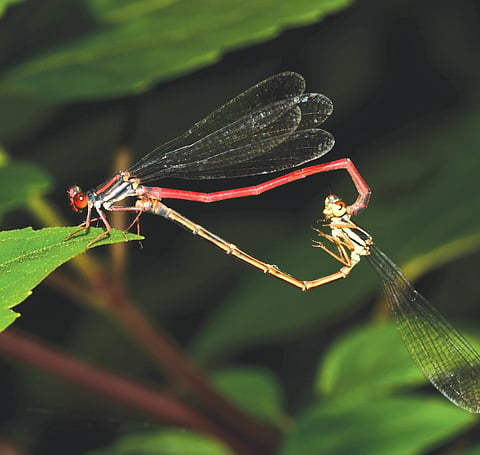

Often the prettiest of creatures is overlooked by us and given a miss, through no fault of the creature concerned. The daintydamselfly is one such insect. On a nature walk with a citizen’s group a few days ago, I kept seeing a lovely damselfly along the jungle track we were on. Nobody else seemed to notice it and I wondered why everyone was overlooking this pretty creature. “So what if no one else is interested,” I muttered to myself. “I am going to keep looking at these marvellous creatures.” The damselfly I spotted was crimson-red with large protruding blood-red eyes. On the thorax of the damselfly were black stripes.
A few metres further on I spotted another damselfly. This one was greenish brown and had bi-coloured eyes — half green and half red. As I kept trudging along the trail I spotted a pair of damselflies mating. It was then I figured out that the red damselfly was the male and the greenish brown one was the female. As is often true in the animal kingdom, males tend to be more handsome than the femaleas they need to attract the female during the mating season. Females are dullcoloured as they are more vulnerable to attack especially when they lay eggs, and don’t want to attract any undue attention to themselves.
After the male and female complete their mating, the female lays her eggs either in water or on an aquatic plant. The larvae of odonates (the animal group to which dragonflies and damselflies belong) are aquatic; hence the eggs of these insects need to be laid in or near water. In many damselfly species the male will accompany the female while she is laying eggs and guard her. The female is most vulnerable when she is laying eggs, so the male helps to even out the odds by offering her protection against other predators. The aquatic larvae of damselflies, just like the adults, are carnivores.
They feed on small insects and their larvae in the water. Once the larvae have fully matured they moult (shed their skin) multiple times. When the larvae is ready to moult one final time, it climbs out of the water and from it emerges the adult damselfly. My observations and musing on the mating damselflies were broken into when other folks on the nature walk butted in to see what I was looking at. Exclamations and “wows” followed as everyone gathered around to watch the damselflies. Making sure that everyone observed and photographed the damselflies from a distance so as not to disturb them, I left the dating and mating insects to continue their cycle of life. (Feedback and queries are welcome at sanjay sondhi1@gmail.com)